ASUS ROG Rapture GT-AX11000 Service Manual

E15154
GT-AX11000
ROG Rapture Tri-band Gaming Router

E15154
First Edition
January 2019
Copyright © 2019 ASUSTeK Computer Inc. All Rights Reserved.
No part of this manual, including the products and software described in it, may be reproduced, transmitted, transcribed, stored in a retrieval
system, or translated into any language in any form or by any means, except documentation kept by the purchaser for backup purposes, without the express written permission of ASUSTeK Computer Inc. (“ASUS”).
Product warranty or service will not be extended if: (1) the product is repaired, modified or altered, unless such repair, modification of alteration is authorized in writing by ASUS; or (2) the serial number of the product is defaced or missing.
ASUS PROVIDES THIS MANUAL “AS IS”WITHOUT WARRANTY OF ANY KIND, EITHER EXPRESS OR IMPLIED, INCLUDING BUT NOT LIMITED TO THE IMPLIED WARRANTIES OR CONDITIONS OF MERCHANTABILITY OR FITNESS FOR A PARTICULAR PURPOSE. IN NO EVENT SHALL ASUS, ITS DIRECTORS, OFFICERS, EMPLOYEES OR AGENTS BE LIABLE FOR ANY INDIRECT, SPECIAL, INCIDENTAL, OR CONSEQUENTIAL DAMAGES (INCLUDING DAMAGES FOR LOSS OF PROFITS, LOSS OF BUSINESS, LOSS OF USE OR DATA, INTERRUPTION OF BUSINESS
AND THE LIKE), EVEN IF ASUS HAS BEEN ADVISED OF THE POSSIBILITY OF SUCH DAMAGES ARISING FROM ANY DEFECT OR ERROR IN THIS MANUAL OR PRODUCT.
SPECIFICATIONS AND INFORMATION CONTAINED IN THIS MANUAL ARE FURNISHED FOR INFORMATIONAL USE ONLY, AND ARE SUBJECT TO CHANGE AT ANY TIME WITHOUT NOTICE, AND SHOULD NOT BE CONSTRUED AS A COMMITMENT BY ASUS. ASUS ASSUMES NO RESPONSIBILITY OR LIABILITY FOR ANY ERRORS OR INACCURACIES THAT MAY APPEAR IN THIS MANUAL, INCLUDING THE PRODUCTS AND SOFTWARE DESCRIBED IN IT.
Products and corporate names appearing in this manual may or may not be registered trademarks or copyrights of their respective companies, and are used only for identification or explanation and to the owners’ benefit, without intent to infringe.
2

Table of contents
1 |
Getting to know your wireless router |
|
1.1 |
Welcome!......................................................................................... |
7 |
1.2 |
Package contents.......................................................................... |
7 |
1.3 |
Your wireless router..................................................................... |
8 |
1.4 |
Positioning your router............................................................ |
10 |
1.5 |
Setup Requirements................................................................. |
11 |
2 |
Getting started |
|
|
2.1 |
Router Setup................................................................................ |
12 |
|
|
A. |
Wired connection.................................................................. |
12 |
|
B. |
Wireless connection.............................................................. |
13 |
2.2 |
Quick Internet Setup (QIS) with Auto-detection............ |
15 |
|
2.3 |
Connecting to your wireless network................................ |
18 |
|
3 |
Configuring the General Settings of ROG |
|
|
Gaming Center |
|
||
3.1 |
Logging into the Web GUI...................................................... |
19 |
|
3.2 |
Dash Board .................................................................................. |
21 |
|
3.3 |
Aiprotection Pro ........................................................................ |
24 |
|
|
3.3.1 |
Configuring Aiprotection Pro............................................ |
25 |
|
3.3.2 |
Blocking Malicious Sites...................................................... |
27 |
|
3.3.3 |
Two-Way IPS............................................................................ |
28 |
|
3.3.4 Infected Device Prevention and Blocking..................... |
29 |
|
|
3.3.5 Setting up Parental Control............................................... |
30 |
|
3.4 |
Game Boost.................................................................................. |
33 |
|
|
3.4.1 |
QoS.............................................................................................. |
34 |
|
3.4.2 |
Web History............................................................................. |
35 |
3.5 |
Game Private Network............................................................. |
36 |
|
3.6 |
Game Profile................................................................................ |
38 |
|
3.7 |
Game Radar................................................................................. |
40 |
|
3.8 |
WiFi Radar..................................................................................... |
42 |
|
|
3.8.1 |
WiFi Site Survey...................................................................... |
43 |
3

Table of contents
|
3.8.2 |
Wireless Channel Statistics................................................. |
44 |
|
3.8.3 |
Advanced Troubleshooting................................................ |
44 |
3.9 |
VPN................................................................................................. |
|
45 |
|
3.9.1 |
VPN Fusion............................................................................... |
46 |
3.10 |
Traffic Analyzer........................................................................... |
48 |
|
4 |
Configuring the Advanced Settings |
|
|
4.1 |
Using the Network Map ......................................................... |
49 |
|
|
4.1.1 Setting up the wireless security settings...................... |
50 |
|
|
4.1.2 Managing your network clients....................................... |
51 |
|
|
4.1.3 Monitoring your USB device.............................................. |
53 |
|
|
4.1.4 |
ASUS AiMesh........................................................................... |
55 |
4.2 |
Wireless......................................................................................... |
61 |
|
|
4.2.1 |
General...................................................................................... |
61 |
|
4.2.2 |
WPS............................................................................................. |
63 |
|
4.2.3 |
Bridge......................................................................................... |
65 |
|
4.2.4 |
Wireless MAC Filter................................................................ |
67 |
|
4.2.5 |
RADIUS Setting....................................................................... |
68 |
|
4.2.6 |
Professional.............................................................................. |
69 |
4.3 |
Creating a Guest Network...................................................... |
73 |
|
4.4 |
LAN.................................................................................................. |
|
75 |
|
4.4.1 |
LAN IP......................................................................................... |
75 |
|
4.4.2 |
DHCP Server............................................................................ |
76 |
|
4.4.3 |
Route.......................................................................................... |
78 |
|
4.4.4 |
IPTV............................................................................................. |
79 |
4.5 |
WAN................................................................................................ |
|
80 |
|
4.5.1 |
Internet Connection............................................................. |
80 |
|
4.5.2 |
Dual WAN.................................................................................. |
83 |
|
4.5.3 |
Port Trigger.............................................................................. |
84 |
|
4.5.4 |
Virtual Server/Port Forwarding......................................... |
86 |
4

Table of contents
|
4.5.5 |
DMZ............................................................................................ |
89 |
|
4.5.6 |
DDNS.......................................................................................... |
90 |
|
4.5.7 |
NAT Passthrough.................................................................... |
91 |
4.6 |
Using the USB Application..................................................... |
92 |
|
|
4.6.1 |
Using AiDisk............................................................................. |
93 |
|
4.6.2 |
Using Servers Center............................................................ |
95 |
|
4.6.3 |
3G/4G...................................................................................... |
100 |
4.7 |
Using AiCloud 2.0.................................................................... |
101 |
|
|
4.7.1 |
Cloud Disk............................................................................. |
102 |
|
4.7.2 |
Smart Access........................................................................ |
104 |
|
4.7.3 |
Smart Sync............................................................................ |
105 |
4.8 |
IPv6............................................................................................... |
|
106 |
4.9 |
Firewall........................................................................................ |
107 |
|
|
4.9.1 |
General................................................................................... |
107 |
|
4.9.2 |
URL Filter................................................................................ |
107 |
|
4.9.3 |
Keyword filter....................................................................... |
108 |
|
4.9.4 |
Network Services Filter..................................................... |
109 |
|
4.9.5 |
IPv6 Firewall.......................................................................... |
110 |
4.10 |
Administration.......................................................................... |
111 |
|
|
4.10.1 Operation Mode.................................................................. |
111 |
|
|
4.10.2 System.................................................................................... |
112 |
|
|
4.10.3 Firmware Upgrade.............................................................. |
113 |
|
|
4.10.4 Restore/Save/Upload Setting......................................... |
113 |
|
4.11 |
System Log................................................................................. |
114 |
|
4.12 |
Smart Connect.......................................................................... |
115 |
|
|
4.12.1 Setting up Smart Connect............................................... |
115 |
|
|
4.12.2 Smart Connect Rule........................................................... |
116 |
|
5

5 |
Utilities |
|
5.1 |
Device Discovery...................................................................... |
119 |
5.2 |
Firmware Restoration............................................................. |
120 |
5.3 |
Setting up your printer server............................................. |
121 |
|
5.3.1 ASUS EZ Printer Sharing................................................... |
121 |
|
5.3.2 Using LPR to Share Printer............................................... |
125 |
5.4 |
Download Master.................................................................... |
130 |
|
5.4.1 Configuring Bit Torrent download settings............... |
131 |
|
5.4.2 NZB settings......................................................................... |
132 |
6 |
Troubleshooting |
|
6.1 |
Basic Troubleshooting............................................................ |
133 |
6.2 |
Frequently Asked Questions (FAQs) ................................. |
135 |
Appendices |
|
|
Notices ..................................................................................................... |
144 |
|
ASUS Contact information................................................................... |
154 |
|
Networks Global Hotline Information............................................. |
155 |
|
6

1Getting to know your wireless router
1.1 Welcome!
Thank you for purchasing ROG Rapture Wireless Router!
The stylish router features 2.4GHz, 5GHz-1 and 5 GHz-2 triple bands for an unmatched concurrent wireless HD streaming; SMB server, UPnP AV server, and FTP server for 24/7 file sharing; a capability to handle 300,000 sessions; and the ASUS Green Network Technology, which provides up to 70% power-saving solution.
1.2 Package contents
ROG Rapture gaming router |
AC adapter |
Network cable (RJ-45) |
Quick Start Guide |
NOTES:
•If any of the items is damaged or missing, contact ASUS for technical inquiries and support, Refer to the ASUS Support Hotline list at the back of this user manual.
•Keep the original packaging material in case you would need future warranty services such as repair or replacement.
7
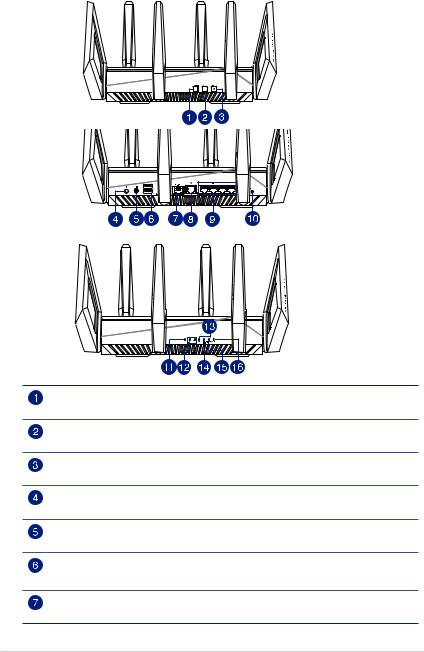
1.3 Your wireless router
Wi-Fi On/Off button
Press this button to turn on /off the Wi-Fi connection.
WPS button
This button launches the WPS Wizard.
Boost Key
Press this button to turn on/off LED, DFS channel, Aura RGB and Game Boost.
Power button
Press this button to power on or off the system.
Power (DC-IN) port
Insert the bundled AC adapter into this port and connect your router to a power source.
USB 3.0 port
Insert USB 3.0 devices such as USB hard disks or USB flash drives into this port.
2.5G Gaming port
Connect network cables into these ports to prioritize the packets.
8

WAN (Internet) port
Connect a network cable into this port to establish WAN connection.
LAN ports
Connect network cables into these ports to establish LAN connection.
Reset button
This button resets or restores the system to its factory default settings.
Power LED
Off: No power.
On: Device is ready.
Flashing slow: Rescue mode.
2.4GHz / 5GHz Wi-Fi LED
Off: No 2.4GHz / 5GHz signal. On:Wireless system is ready.
Flashing:Transmitting or receiving data via wireless connection.
WAN (Internet) LED
Red: No IP or no physical connection.
On: Has physical connection to a wide area network (WAN).
LAN LED
Off: No power or no physical connection.
On: Has physical connection to a local area network (LAN).
2.5G Gaming port LED
Off: No 2.5G gaming port connection.
On: Has physical connection to 2.5G gaming port.
WPS LED
Off:WPS verification process is off or completed.
Flashing:WPS verification process is activated.
NOTES:
•Use only the adapter that came with your package. Using other adapters may damage the device.
•Specifications:
|
DC Power adapter |
DC Output: +19V with max 3.42A current |
|
||
|
|
|
|
|
|
|
Operating |
0~40oC |
Storage |
0~70oC |
|
|
Temperature |
|
|
|
|
|
Operating Humidity |
50~90% |
Storage |
20~90% |
|
|
|
|
|
|
|
9
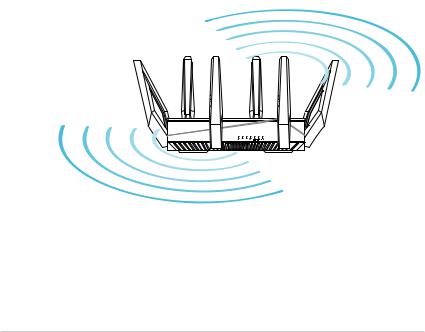
1.4 Positioning your router
For the best wireless signal transmission between the wireless router and the network devices connected to it, ensure that you:
•Place the wireless router in a centralized area for a maximum wireless coverage for the network devices.
•Keep the device away from metal obstructions and away from direct sunlight.
•Keep the device away from 802.11g or 20MHz onlyWi-Fi devices, 2.4GHz computer peripherals, Bluetooth devices, cordless phones, transformers, heavy-duty motors, fluorescent lights, microwave ovens, refrigerators, and other industrial equipment to prevent signal interference or loss.
•Always update to the latest firmware.Visit the ASUS website at http://www.asus.com to get the latest firmware updates.
•To ensure the best wireless signal,orient the four detachable antennas as shown in the drawing below.
10

1.5 Setup Requirements
To set up your wireless network, you need a computer that meets the following system requirements:
•Ethernet RJ-45 (LAN) port (10Base-T/100Base-
TX/1000BaseTX)
•IEEE 802.11a/b/g/n/ac/ax wireless capability
•An installedTCP/IP service
•Web browser such as Internet Explorer, Firefox, Safari, or
Google Chrome
NOTES:
•If your computer does not have built-in wireless capabilities, you may install an IEEE 802.11a/b/g/n/ac/ax WLAN adapter to your computer to connect to the network.
•With its triple band technology, your wireless router supports
2.4GHz, 5GHz-1 and 5GHz-2 wireless signals simultaneously. This allows you to do Internet-related activities such as Internet surfing or reading/writing e-mail messages using the 2.4GHz band while simultaneously streaming high-definition audio/video files such as movies or music using the 5GHz band.
•Some IEEE 802.11n devices that you want to connect to your network may or may not support 5GHz band. Refer to the device's manual for specifications.
•The Ethernet RJ-45 cables that will be used to connect the network devices should not exceed 100 meters.
IMPORTANT!
•Some wireless adapters might have connectivity issues to
802.11ax WiFi APs.
•If you’re experiencing such issue, please ensure you update the driver to the latest version. Check your manufacturer's official support site where software drivers, updates, and other related information can be obtained.
•Realtek: https://www.realtek.com/en/downloads
•Mediatek: https://www.mediatek.com/products/connectivity- and-networking/broadband-wifi
•Intel: https://downloadcenter.intel.com/
11
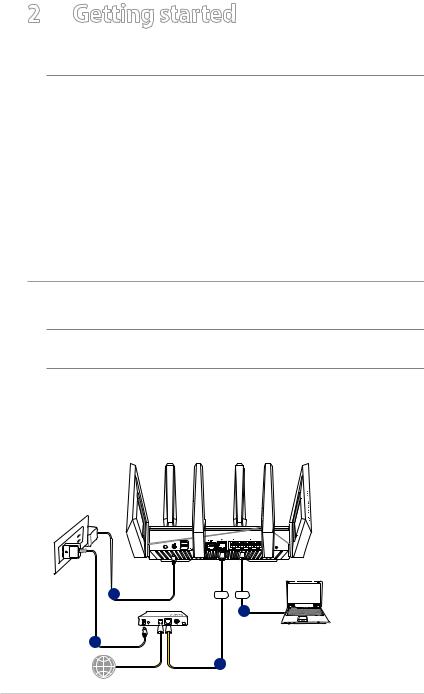
2 Getting started
2.1 Router Setup
IMPORTANT!
•Use a wired connection when setting up your wireless router to avoid possible setup problems.
•Before setting up your ASUS wireless router, do the following:
•If you are replacing an existing router, disconnect it from your network.
•Disconnect the cables/wires from your existing modem setup. If your modem has a backup battery, remove it as well.
•Reboot your cable modem and computer (recommended).
A.Wired connection
NOTE:You can use either a straight-through cable or a crossover cable for wired connection.
To set up your wireless router via wired connection:
1.Plug your router into a power outlet and power it on. Connect the network cable from your computer to a LAN port on your router.
|
WAN LAN |
Modem |
2 |
|
4 |
3
Internet
12

2.The web GUI launches automatically when you open a web browser. If it does not auto-launch, enter http://router.asus.com
3.Set up a password for your router to prevent unauthorized access.
B.Wireless connection
To set up your wireless router via wireless connection:
1. Plug your router into a power outlet and power it on.
Smart phone
|
Tablet |
Modem |
WAN |
3 |
|
|
2 |
Internet |
Laptop |
2.Connect to the network name(SSID) shown on the product label on the back side of the router. For better network security, change to a unique SSID and assign a password.
13
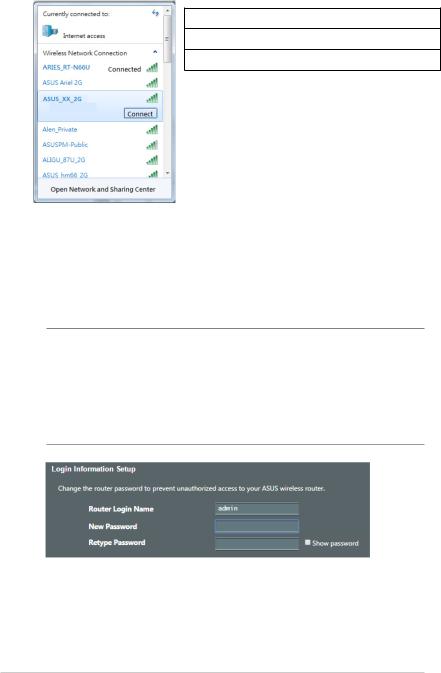
ASUS router
2.4G Wi-Fi Name (SSID): ASUS_XX_2G
5G-1 Wi-Fi Name (SSID): ASUS_XX_5G
5G-2 Wi-Fi Name (SSID): ASUS_XX_5G_Gaming
*XX refers to the last two digits of 2.4GHz MAC address. You can find it on the label on the back of your ROG router.
3.Once connected, the web GUI launches automatically when you open a web browser. If it does not auto-launch, enter http://router.asus.com.
4.Set up a password for your router to prevent unauthorized access.
NOTES:
•For details on connecting to a wireless network, refer to theWLAN adapter’s user manual.
•To set up the security settings for your network, refer to the section Setting up the wireless security settings in Chapter 3 of this user manual.
14

2.2Quick Internet Setup (QIS) with Autodetection
The Quick Internet Setup (QIS) function guides you in quickly setting up your Internet connection.
NOTE: When setting the Internet connection for the first time, press the Reset button on your wireless router to reset it to its factory default settings.
To use QIS with auto-detection:
1.Launch a web browser. You will be redirected to the ASUS Setup Wizard (Quick Internet Setup). If not, key in http://router.asus.com manually.
2.The wireless router automatically detects if your ISP connection type is Dynamic IP, PPPoE, PPTP and L2TP. Key in the necessary information for your ISP connection type.
IMPORTANT! Obtain the necessary information from your ISP about the Internet connection type.
15

NOTES:
•The auto-detection of your ISP connection type takes place when you configure the wireless router for the first time or when your wireless router is reset to its default settings.
•If QIS failed to detect your Internet connection type, click Skip to manual setting and manually configure your connection settings.
3.Assign the wireless network name (SSID) and security key for your 2.4GHz and 5 GHz wireless connection. Click Apply when done.
16

4.On the Login Information Setup page, change the router’s login password to prevent unauthorized access to your wireless router.
NOTE: The wireless router's login username and password is different from the 2.4GHz/5GHz network name (SSID) and security key. The wireless router's login username and password allows you to log into your wireless router's Web GUI to configure your wireless router's settings. The 2.4GHz/5GHz network name (SSID) and security key allows Wi-Fi devices to log in and connect to your 2.4GHz/5GHz network.
17

2.3 Connecting to your wireless network
After setting up your wireless router via QIS, you can connect your computer or other smart devices to your wireless network.
To connect to your network:
1.On your computer, click the network icon  in the notification area to display the available wireless networks.
in the notification area to display the available wireless networks.
2.Select the wireless network that you want to connect to, then click Connect.
3.You may need to key in the network security key for a secured wireless network, then click OK.
4.Wait while your computer establishes connection to the wireless network successfully. The connection status is
displayed and the network icon displays the connected  status.
status.
NOTES:
•Refer to the next chapters for more details on configuring your wireless network's settings.
•Refer to your device's user manual for more details on connecting it to your wireless network.
18

3Configuring the General Settings of ROG Gaming Center
3.1 Logging into the Web GUI
Your ROG Rapture gaming router comes with an intuitive web graphical user interface (GUI) - ROG Gaming Center, which gives you total network control, with need-to-know information such as connected device status and worldwide game-server ping values, and instant access to all the amazing gaming features.
NOTE: The features may vary with different firmware versions.
To log into the web GUI:
1.On your web browser, manually key in the wireless router’s default IP address: http://router.asus.com.
2.On the login page, key in the default user name (admin) and the password that you have set in 2.2 Quick Internet Setup (QIS) with Auto-dection.
3.You can now use the Web GUI to configure various settings of your ASUS Wireless Router.
19

Top command buttons
Information QIS - Smart 
 banner
banner
Connect
Wizard
Navigation
panel
NOTE:If you are logging into the Web GUI for the first time, you will be directed to the Quick Internet Setup (QIS) page automatically.
20

3.2 Dash Board
Dash Board allows you to monitor the real-time traffic for your networking environment and analyze the real-time network ping and ping deviation.
Network ping refers to online game experiences. Higher ping means higher latency for real-time games. For most online games, network ping that is less than 99 ms is considered good quality. If network ping is less than 150 ms, the quality is acceptable. Generally, if network ping is more than 150 ms, it is hard to play game smoothly.
Ping deviation is also highly related with online game experiences. With higher ping deviation, it is much easier causing possible toggle when playing online game. There is no baseline for ping deviation. However, lower ping deviation is better.
21

•Game Radar: Game Radar from Dashboard could give you a quick look about ping time for specific game server.
22

•Aura RGB: Allows users to define or turn on/off the Aura RGB from Dashboard. You can setup any color and choose either of the five lighting patterns.
•Boost Key: ROG Rapture gaming router supports Boost Key and allows users to define the functions of Boost Key from Dashboard.
•LED on/off
•DFS channel on/off
•Aura RGB on/off
•Game Boost: enable/disable prioritizing the gaming packet.
23
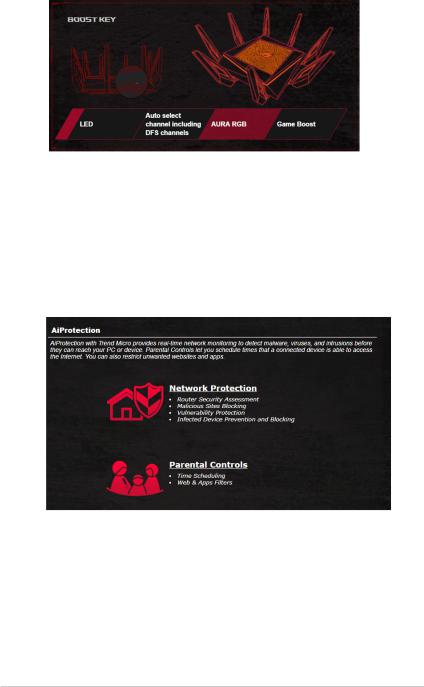
3.3 Aiprotection Pro
Aiprotection Pro provides real-time monitoring that detects malware, spyware, and unwanted access. It also filters unwanted websites and apps and allows you to schedule Internet access time for a connected device.
24

3.3.1 Configuring Aiprotection Pro
Aiprotection Pro prevents network exploits and secures your network from unwanted access.
To Configure Aiprotection Pro:
1.From the navigation panel, go to General > Aiprotection Pro.
2.From the Aiprotection Pro main page, click Network Protection.
3.From the Network Protection tab, click Scan.
The search results are displayed on the Router Security Assessment page.
25

IMPORTANT! Items marked with Yes on the Router Security Assessment page are considered to be safe.
4.(Optional) From the Router Security Assessment page, manually configure the items marked as No, Weak, or Very Weak.To do this:
a.Click an item to go to the item’s setting page.
b.From the item’s security settings page, configure and make the necessary changes and click Apply when done.
c.Go back to the Router Security Assessment page and click Close to exit the page.
5.Click OK on the confirmation message.
26

3.3.2 Blocking Malicious Sites
This feature restricts access to known malicious websites in the cloud database for an always-up-to-date protection.
NOTE:This function is automatically enabled if you run the Router Weakness Scan.
To enable Malicious Sites Blocking:
1.From the navigation panel, go to General > Aiprotection Pro.
2.From the Aiprotection Pro main page, click Network Protection.
3.From the Malicious Sites Blocking pane,click ON.
27

3.3.3 Two-Way IPS
This feature resolves common exploits within the router configuration.
NOTE:This function is automatically enabled if you run the Router Weakness Scan.
To enable Two-Way IPS:
1.From the navigation panel, go to General > Aiprotection Pro.
2.From the Aiprotection Pro main page, click Network Protection.
3.From the Two-Way IPS pane, click ON.
28

3.3.4 Infected Device Prevention and Blocking
This feature prevents infected devices from communicating personal information or infected status to external parties.
NOTE:This function is automatically enabled if you run the Router Weakness Scan.
To enable infected device prevention and blocking:
1.From the navigation panel, go to General > Aiprotection Pro.
2.From the Aiprotection Pro main page, click Network Protection.
3.From the Infected Device Prevention and Blocking pane, click
ON.
To configure Alert Preference:
1.From the Infected Device Prevention and Blocking pane, click
Alert Preference.
2.Select or key in the e-mail provider, e-mail account, and password then click Apply.
29
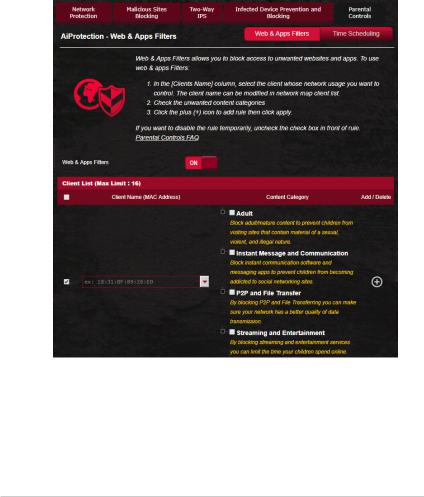
3.3.5 Setting up Parental Control
Parental Control allows you to control the Internet access time or set the time limit for a client’s network usage.
To enable Two-Way IPS:
1.From the navigation panel, go to General > Aiprotection Pro.
2.From the Aiprotection Pro main page, click Parental Controls tab.
30
